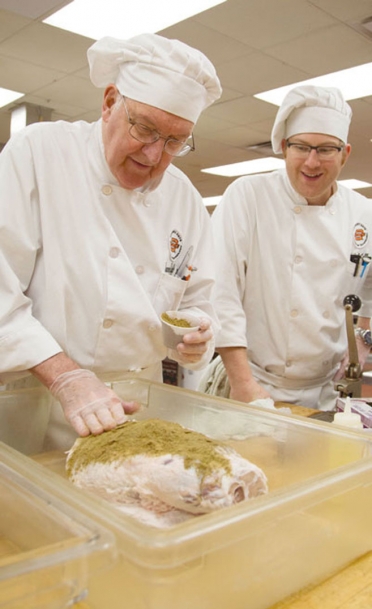Changing Seasons
Culinary school offers fresh starts for all ages
If you head south from Tulsa on US 75 about 30 miles, take a left on the OK 56 Loop and follow it around, you’ll see OSU Institute of Technology two and half miles up the road on the right. OSUIT is one of the five campuses that make up the Oklahoma State University system. Since 1946, OSUIT has been inviting students to enroll in everything from the School of Energy Technologies to the School of Watchmaking.
Prominent among the many offerings is the School of Culinary Arts. With a faculty diverse in both culinary technique and culinary vision, OSUIT provides students a top-notch culinary education right down the road from Tulsa.
According to instructor Chef Ron L’heureux, there has been a change in the type of students the program attracts today compared to when he started teaching in the mid-’90s. Rather than attracting mostly students straight out of high school that “didn’t know what they wanted to do,” he says, OSUIT is now “getting people who seem like they’re more interested in” food and learning to cook.
Dr. James Lockhart, who retired from a 50-year career as a general surgeon in 2014, is one such student. Lockhart enrolled at OSUIT in April 2015, only six months after retiring. He is what you’d call a “foodie” and had been dreaming of attending culinary school for years. Always inquisitive and eager to learn new things, Lockhart remembers taking Chef L’Heureux’s American Regional Cooking course at what was then OSU-Okmulgee in the 1990s. Little did he know that he’d find his way back into Chef L’Heureux’s kitchen once again.
After he retired, Lockhart decided to actually take courses at the school rather than attending a chef-led tutorial. He soon discovered that, as with any skill, you must start with the basics: Learning the fundamentals of cooking before applying them is key.
Therefore, Lockhart—like any other new student—needed to take Skills I and Skills II before being allowed to enroll in other culinary courses. These courses provide the foundation for more advanced courses: basic knife skills, stocks, mother sauces and other essential parts of a cooking repertoire. The skills courses are also where you learn discipline, show your dedication, as well as demonstrate your willingness to practice those skills. For Lockhart, a practicing surgeon for decades, this was nothing new—although he says that using a scalpel is nothing like using a 9-inch chef ’s knife.
Lockhart attends his Skills class from 9am to 1pm, Monday through Friday. This, in and of itself, is dedication. Once his Skills I and II courses are finished, he will focus on those courses he is most interested in: baking, meat fabrication and garde manger in particular. Lockhart does not plan to take all the courses necessary for a degree. Rather, he’s taking those courses as steps toward possibly fulfilling another fantasy: working as a professional chef.
Another nontraditional OSUIT student is James Wegner. Originally a meteorologist from Edmonton, Alberta, Wegner moved to Tulsa in August 2014 when his wife, a surgeon, took a job here in Tulsa. Wegner admits that he has not always been a foodie. While “at university” in Edmonton he, like many of us, ate at the various chain eateries around. However, after leaving school he soon discovered a passion and love of food that had not existed before. Serendipity struck after he moved to Tulsa and discovered that the right job for him wasn’t available. He took it as a sign, and after touring the facility with culinary department head Chef Rene Jungo, Wegner decided going back to school was the right choice. Unlike Lockhart, he is going after his degree.
Wegner is on track to graduate in five semesters with his Associates in Culinary Arts degree. So far, he says, culinary school is “a lot better” than he thought it would be. He attributes this to a “level of instruction” that is beyond what he expected and to the minimal time spent in a classroom setting, with more time spent in the kitchens preparing and cooking food. He, like many, would rather be out in the kitchen cooking than having his nose in a textbook.
Wegner had minimal kitchen experience before enrolling, but he’s making up for that by getting real-world restaurant experience working part-time at La Villa in the Philbrook Museum. He attributes the job to Chef Aaron Ware, another OSUIT instructor. At La Villa, if he’s not in the kitchen doing food prep, you can often find him manning the omelet station at La Villa’s famous Sunday brunch. Wegner does plan on working professionally upon graduation.
Passion for food is an interesting thing. On any given day, you can have a retired surgeon and a Canadian expat meteorologist both trying to make a consommé that isn’t cloudy or a Hollandaise that isn’t grainy and broken, just like the rest of the youngsters in their class.
What a passion for food is not is a young person’s game. A love of food, much like love for a person, can hit you at any point in your life. All you have to do is seize it. That’s what Dr. Lockhart and James Wegner did. You can too.




